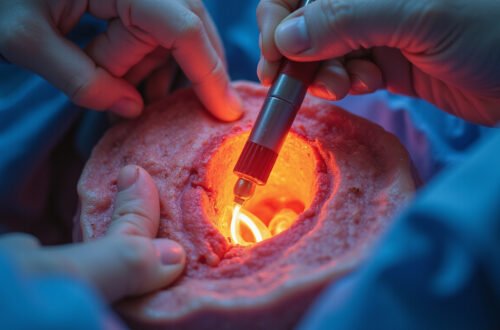Lumbar nerve root disorders are conditions that affect the nerves emerging from the lumbar spine, often leading to pain, weakness, and sensory changes in the lower back and legs. Understanding lumbar nerve root disorders is essential for early diagnosis and effective treatment. These disorders typically result from compression or irritation of the nerve roots in the lower back, causing symptoms that can range from mild discomfort to severe disability. In this comprehensive guide, we’ll explore the common symptoms, underlying causes, and various treatment options for lumbar nerve root disorders.
What Are Lumbar Nerve Root Disorders?
The lumbar nerve roots are the nerves that branch out from the spinal cord in the lower back region (lumbar spine). There are five pairs of lumbar nerve roots (L1 to L5), and they provide sensation and motor control to parts of the lower body, including the legs and feet. Lumbar nerve root disorders occur when these nerve roots are compressed, inflamed, or damaged, disrupting their function.
Common conditions that fall under lumbar nerve root disorders include lumbar radiculopathy (commonly known as sciatica), herniated discs, spinal stenosis, and foraminal stenosis. These disorders can lead to symptoms such as radiating pain, numbness, or weakness.
Symptoms of Lumbar Nerve Root Disorders
Symptoms vary based on the specific nerve root affected and the severity of compression or irritation. The most commonly affected nerve roots are L4, L5, and S1, leading to distinct symptom patterns.
Typical symptoms include:
- Lower back pain that may extend into the buttocks, thighs, or legs
- Radiating leg pain (sciatica) following the path of the affected nerve
- Numbness or tingling in the legs and feet
- Muscle weakness in the legs or feet, which may affect walking or standing
- Reflex changes such as decreased knee or ankle reflexes
Patients may describe pain that worsens with certain movements like bending, coughing, or sitting for long periods.
Causes of Lumbar Nerve Root Disorders
Several factors can lead to lumbar nerve root disorders, with the most common being:
-
Herniated Disc
Also called a slipped or ruptured disc, this occurs when the soft interior of a spinal disc protrudes through the tougher exterior, compressing a nearby nerve root. -
Spinal Stenosis
Narrowing of the spinal canal or nerve root openings (foramina) can compress nerve roots, often due to age-related degenerative changes. -
Degenerative Disc Disease
Breakdown of spinal discs reduces the space between vertebrae, potentially causing nerve root irritation. -
Bone Spurs (Osteophytes)
Bony growths from arthritis can narrow nerve passageways. -
Trauma or Injury
Accidents or injuries may cause vertebral fractures or dislocations that impinge nerve roots. -
Tumors or Infections
Although less common, abnormal growths or infections can also affect nerve root function.
Understanding the cause is critical for guiding effective treatment.
Diagnosing Lumbar Nerve Root Disorders
Diagnosis begins with a thorough medical history and physical examination focused on neurological function, including:
- Testing muscle strength
- Assessing reflexes
- Evaluating sensation in affected areas
- Performing specific maneuvers like the straight leg raise test
Imaging studies are essential to identify the underlying pathology. Common diagnostic tools include:
- Magnetic Resonance Imaging (MRI): The gold standard for visualizing soft tissues, discs, and nerve roots.
- Computed Tomography (CT) Scan: Helpful when MRI is contraindicated or to view bone structures.
- X-rays: Useful for assessing bone alignment and degenerative changes.
- Electromyography (EMG) and Nerve Conduction Studies: Measure electrical activity and nerve conduction to detect nerve damage.
An accurate diagnosis enables tailored treatment plans.
Treatment Options for Lumbar Nerve Root Disorders
Treatment depends on the severity of symptoms, underlying cause, and patient health. Most cases respond well to conservative management, while surgery is reserved for persistent or severe cases.
Conservative Treatments
-
Medications
- Nonsteroidal anti-inflammatory drugs (NSAIDs) to reduce pain and inflammation
- Muscle relaxants to alleviate spasm
- Oral corticosteroids or epidural steroid injections for severe inflammation
-
Physical Therapy
A tailored exercise regimen strengthens the muscles supporting the spine, improves flexibility, and relieves nerve pressure. -
Activity Modification
Avoiding activities that exacerbate symptoms and learning proper body mechanics reduces strain on the lumbar spine. -
Heat and Cold Therapy
Applying heat or ice packs can decrease pain and inflammation. -
Alternative Therapies
Acupuncture and chiropractic care may provide symptom relief for some patients.

Surgical Treatments
Surgery may be necessary if:
- Symptoms persist despite conservative therapy
- There is significant muscle weakness or loss of bladder/bowel control
- Imaging shows severe nerve compression
Common surgical procedures include:
- Microdiscectomy: Removal of herniated disc material pressing on nerve roots
- Laminectomy: Removal of part of the vertebra (lamina) to decompress nerves
- Foraminotomy: Widening the nerve root exit passage to relieve pressure
Surgical outcomes are generally favorable, particularly when pain and neurological deficits are severe.
Preventing Lumbar Nerve Root Disorders
Prevention strategies can minimize the risk of developing lumbar nerve root issues:
- Maintain a healthy weight to reduce spinal stress
- Practice good posture, especially when sitting or lifting heavy objects
- Engage in regular exercise focusing on core strength and flexibility
- Avoid smoking, as it impairs disc health and healing
- Use ergonomic furniture and support to protect your lumbar spine
FAQs About Lumbar Nerve Root Disorders
Q1: What is lumbar nerve root compression, and how does it cause pain?
Lumbar nerve root compression occurs when the nerve roots in the lower spine are pinched or irritated by disc herniation, bone spurs, or swelling. This pressure disrupts nerve signaling and causes pain, numbness, or weakness in the lower back and legs.
Q2: How long does it take to recover from a lumbar nerve root disorder?
Recovery time varies by severity and treatment. Many cases improve within weeks of conservative care, but chronic or severe cases may take months or require surgery.
Q3: Can lumbar nerve root disorders cause permanent damage?
If left untreated, severe compression can lead to permanent nerve damage, resulting in weakness or loss of sensation. Early diagnosis and treatment reduce this risk.
Authoritative Source
For more detailed information on lumbar nerve root disorders and treatment guidelines, the American Academy of Orthopaedic Surgeons provides comprehensive resources (source).
Conclusion: Take Charge of Your Lumbar Health Today
Lumbar nerve root disorders can significantly impact quality of life, but with proper understanding and timely intervention, most people regain function and reduce pain effectively. If you experience persistent lower back pain, radiating leg pain, or neurological symptoms, don’t ignore these warning signs. Consult a healthcare professional to get a precise diagnosis and a treatment plan tailored to your needs. Early action can prevent complications and help you return to your daily activities faster. Take control of your spinal health today – your lower back will thank you!






